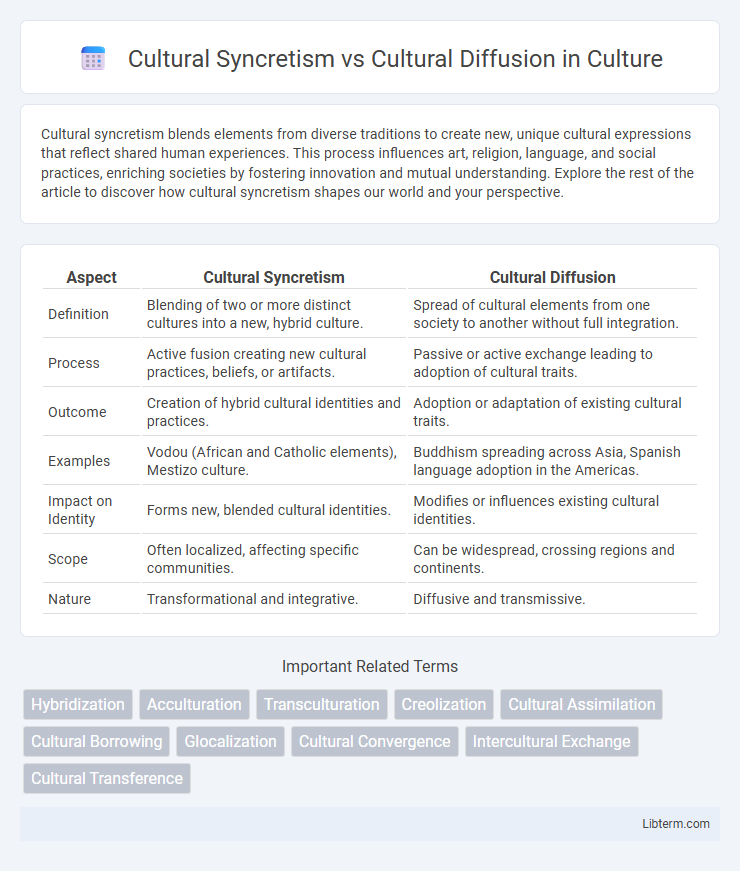Cultural syncretism blends elements from diverse traditions to create new, unique cultural expressions that reflect shared human experiences. This process influences art, religion, language, and social practices, enriching societies by fostering innovation and mutual understanding. Explore the rest of the article to discover how cultural syncretism shapes our world and your perspective.
Table of Comparison
| Aspect | Cultural Syncretism | Cultural Diffusion |
|---|---|---|
| Definition | Blending of two or more distinct cultures into a new, hybrid culture. | Spread of cultural elements from one society to another without full integration. |
| Process | Active fusion creating new cultural practices, beliefs, or artifacts. | Passive or active exchange leading to adoption of cultural traits. |
| Outcome | Creation of hybrid cultural identities and practices. | Adoption or adaptation of existing cultural traits. |
| Examples | Vodou (African and Catholic elements), Mestizo culture. | Buddhism spreading across Asia, Spanish language adoption in the Americas. |
| Impact on Identity | Forms new, blended cultural identities. | Modifies or influences existing cultural identities. |
| Scope | Often localized, affecting specific communities. | Can be widespread, crossing regions and continents. |
| Nature | Transformational and integrative. | Diffusive and transmissive. |
Defining Cultural Syncretism
Cultural syncretism refers to the blending of different cultural beliefs and practices into a new, cohesive system, often resulting from prolonged contact and interaction between distinct societies. It contrasts with cultural diffusion, which involves the spread of cultural elements from one group to another without necessarily merging them into a unified form. Examples of cultural syncretism include the fusion of indigenous and colonial religious practices in Latin America, creating unique hybrid traditions.
Understanding Cultural Diffusion
Cultural diffusion refers to the spread of cultural elements, such as ideas, beliefs, technologies, and customs, from one society to another, shaping and transforming local cultures over time. It involves the exchange and adoption of cultural traits through trade, migration, communication, and conquest, creating a dynamic flow of cultural influence. Understanding cultural diffusion highlights how cultures evolve through interaction rather than isolation, leading to increased diversity and innovation within global societies.
Key Differences Between Syncretism and Diffusion
Cultural syncretism involves the blending and merging of distinct cultural elements to create a new, hybrid culture, while cultural diffusion refers to the spread of cultural traits from one society to another without merging. Syncretism results in a transformative synthesis that alters original cultural identities, whereas diffusion allows cultures to adopt traits while maintaining their core characteristics. Key differences lie in syncretism's creation of new cultural forms compared to diffusion's transmission process.
Historical Examples of Cultural Syncretism
Cultural syncretism is exemplified by the blending of Hellenistic and Egyptian religious practices during the Ptolemaic dynasty, creating new deities like Serapis that combined elements from both cultures. The fusion of indigenous African religions with Islam in West Africa led to unique spiritual customs that illustrate cultural syncretism. Another historical instance includes the fusion of Spanish and Indigenous American traditions in Latin America, visible in religious festivals and practices that merge Catholicism with native beliefs.
Iconic Cases of Cultural Diffusion
Iconic cases of cultural diffusion include the spread of Buddhism from India to East Asia through the Silk Road and the Columbian Exchange's introduction of crops like potatoes and maize between the Americas and Europe. Cultural diffusion involves the transmission of cultural elements such as ideas, practices, and technologies across different societies, often resulting in adaptation and transformation. In contrast, cultural syncretism blends distinct cultural traditions into new, hybrid forms, seen in mestizo cultures in Latin America where indigenous and European influences merge uniquely.
Mechanisms Facilitating Syncretism
Mechanisms facilitating cultural syncretism include direct interaction through trade, migration, and conquest, which allow for the blending of religious practices, languages, and artistic traditions. Syncretism often occurs when societies adopt and adapt foreign elements into a cohesive new cultural framework, driven by mutual accommodation and hybridization. This process contrasts with cultural diffusion, which primarily involves the spread of cultural traits without the deep integration or transformation characteristic of syncretism.
Drivers and Channels of Diffusion
Drivers of cultural syncretism often include migration, trade, and conquest, which create environments for blending beliefs and practices. Channels of cultural diffusion encompass communication networks, media, technology, and interpersonal interactions that facilitate the spread of cultural elements across populations. Cultural syncretism actively combines diverse traditions into new forms, whereas diffusion primarily involves the transmission of existing cultural traits without significant transformation.
Impact on Language, Religion, and Art
Cultural syncretism blends elements from different traditions, creating hybrid languages, religions, and art forms that reflect a fusion of influences, such as the development of Creole languages and syncretic religious practices like Vodou. Cultural diffusion spreads cultural traits across societies without necessarily merging them, leading to the adoption of foreign words, religious beliefs, and artistic styles while maintaining distinct cultural identities. The impact on language includes loanwords and pidgins in diffusion, versus mixed or newly formed languages in syncretism; religious impact ranges from coexistence of multiple deities to integrated ritual systems, and art transforms through either parallel adaptation or innovative hybridization.
Challenges and Criticisms of Both Processes
Cultural syncretism faces challenges such as the loss of original cultural identities and accusations of cultural appropriation, which can lead to tensions between dominant and marginalized groups. Cultural diffusion encounters criticism for promoting cultural homogenization and the erosion of unique traditions, often exacerbated by unequal power dynamics and globalization. Both processes must navigate complex ethical considerations regarding respect, authenticity, and the balance between cultural exchange and preservation.
Contemporary Relevance and Globalization
Cultural syncretism shapes contemporary societies by blending diverse traditions into innovative cultural identities, fostering unique social practices and expressions in a globalized world. Cultural diffusion drives globalization through the widespread exchange and adaptation of technologies, languages, and customs, accelerating interconnectedness across continents. Both processes influence global cultural dynamics, affecting commerce, communication, and socio-political interactions in the 21st century.
Cultural Syncretism Infographic

 libterm.com
libterm.com